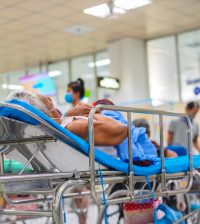- Screen Pregnant Women for Syphilis, Ob-Gyn Group Advises
- Even With Weight Gain, Quitting Smoking in Pregnancy Still Best for Health
- A-Fib Is Strong Precursor to Heart Failure
- One Neurological Factor Keeps Black, Hispanic Patients From Alzheimer’s Clinical Trials
- Managing Blood Sugar After Stroke Could Be Key to Outcomes
- Dozens of COVID Virus Mutations Arose in Man With Longest Known Case
- Blood Test Might Someday Diagnose Early MS
- Check Your Fridge for Trader Joe’s Fresh Basil, Linked to Salmonella
- Rising Number of Americans Sent to ERs Last Year During Heat Waves
- Big Health Care Disparities Persist Across the U.S., New Report Finds
Child ‘Cured’ of HIV Remains Free of Virus, Doctors Report


WEDNESDAY, Oct. 23A 3-year-old Mississippi girl apparently cured of HIV infection by aggressive treatment right after her birth remains free of the virus, her doctors report.
Early treatment with a combination of potent antiretroviral drugs appears to have kept the virus from successfully establishing a reservoir in the child’s system, said immunologist Dr. Katherine Luzuriaga, of the University of Massachusetts Medical School, who is part of the research team tracking the case.
Doctors are hesitant to declare the child fully cured, but in a case update reported in the Oct. 24 issue of the New England Journal of Medicine they said that no actively replicating HIV has been found in her system by even the most sensitive tests available. The girl stopped taking HIV medication when she was 18 months old.
A couple of tests have found very low-level indications of HIV in the girl’s blood, but doctors cannot tell if they are false positives or simply remnants of the eradicated virus.
“If they are remnants, the question is whether they are capable of reigniting,” Luzuriaga said. “For that reason, we are calling this a remission because we want to follow the baby over a longer period of time to see if the child continues to control the virus without rebound.”
The girl stands as the first documented case of HIV remission in a child. Early findings in the case were first presented in March during a scientific meeting in Atlanta, but the new report adds critical details.
The girl’s pediatrician, Dr. Hannah Gay, of the University of Mississippi Medical Center, launched HIV treatment just 30 hours following her birth, according to the report.
Doctors normally put HIV-positive mothers on two antiretroviral medications prior to birth as a way of preventing transmission of the virus to their unborn children, Luzuriaga said. After delivery, doctors test the newborns for HIV and continue treatment if the virus appears.
But in this girl’s case, no one knew the mother was HIV-positive before delivery and the girl was born infected. This led Gay to put the newborn on antiretroviral treatment immediately, and that timing appears to have made a difference.
Gay also chose to employ a combination of three antiretroviral drugs, all at doses commonly used to treat HIV-infected infants, and kept the girl on the medications until she was 18 months old. This prevented the virus from mounting any drug resistance before it could be wiped clean from her body, Luzuriaga said.
Tests showed progressively diminishing HIV levels in the infant’s blood, until it reached undetectable levels 29 days after birth. The child remained on antiretrovirals until 18 months of age, at which point doctors said they lost track of her and she stopped treatment.
Doctors next saw her about 10 months after her treatment ceased. The child underwent repeated standard HIV tests, which detected no virus in her blood.
The two factors — timing and medication — appear to have prevented HIV from gaining a foothold in the girl’s immune system. The virus was unable to create a reservoir in her body in which dormant HIV can hide and later reignite when drug therapy is suspended.
“What studies in other babies have shown us is if you treat very early, you’re not only able to treat the viral replication but also able to limit the number of cells in which HIV integrates itself into the host genes,” Luzuriaga said. “Basically, HIV makes copies of DNA and that DNA integrates itself into host genes. That’s the barrier to cure. As long as you have those white blood cells floating around the body that have HIV stitched into the host DNA, the patient is not cured.”
A key point is that the child exhibits none of the immune characteristics seen in “elite controllers,” the tiny percentage of HIV-infected people whose immune systems are so active that they can keep the virus in check without treatment, the researchers said. The absence of these characteristics indicates that early therapy — rather than natural immune mechanisms — led to the child’s remission.
Based on this girl’s case, a federally funded study set to begin in early 2014 will test the early treatment method to determine whether the approach could be used in all HIV-infected newborns.
This method could cure newborns infected with HIV but is unlikely to help adults, given that they rarely learn of their infection until months or years after transmission, said Dr. Rowena Johnston, vice president of research at the Foundation for AIDS Research (amfAR).
“If there is something key to treating HIV within the first couple of days of transmission, it’s going to be incredibly difficult to treat adults in this manner,” Johnston said. “But this case really opens up the possibility that there may be different HIV cures for different populations, depending on what the circumstances are.”
Dr. Michael Horberg, director of HIV/AIDS treatment and research for Kaiser Permanente, agreed that the infant’s case is very encouraging, but said it’s not an indication of a potential cure for all people with HIV.
“This is a very unique situation, but it does show that very early treatment is very successful,” Horberg said. “We can envision potential future pathways with correct medication and vigilance where there might be a percentage of patients who could be successfully treated.”
Only one other instance of an HIV cure has been documented, in the so-called “Berlin patient.” An American man living in Germany received a bone marrow transplant for leukemia, with cells from a donor who had a rare genetic mutation that increases immunity against HIV. This patient has remained HIV-free after discontinuing drug therapy.
More information
Visit the U.S. Department of Health and Human Services for more on HIV infection.
Source: HealthDay
Copyright © 2024 HealthDay. All rights reserved.










